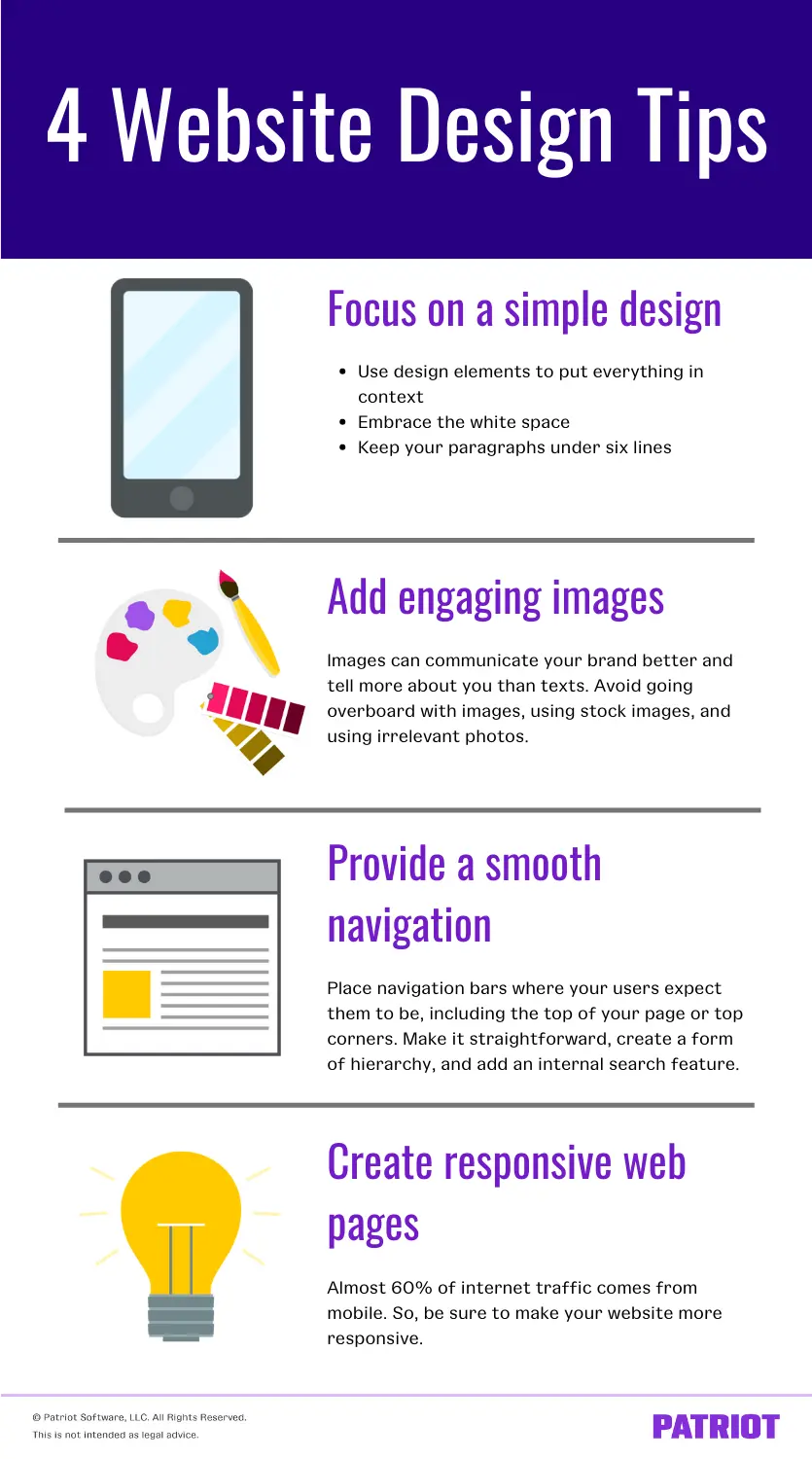“What exactly is wrong with my website?” Nothing seems to be working. The conversion rate is pedaling backward. Bounce rates keep reaching and breaking all-time highs. Everything is just stuck in an unrewarding cycle of generating and losing leads.
If this is you, you need to reassess your website design.
You have only a few seconds to make an impression on your potential customers. So if you fail to do that with your small business website design, your visitors will leave.
Now, the million-dollar question is: How can you optimize your online presence and maximize its appeal?
4 Website design tips
Follow this four-step guide as we discuss proven tips that can change the game of your website design today.

1. Focus on a simple design
According to Google research, the more your design elements (pictures, titles, texts, etc.), the more your user experience and conversion drop.
No one wants to use a website where the colors, texts, images, etc., compete for attention. So, use these elements optimally. Let them tell a cohesive story. Keep your paragraphs under six lines as well to make them scannable.
The golden rule of website design and digital marketing is “embrace the white space.” White space helps you create cohesiveness and balance in the design. It makes your website look uncluttered. As such, you can efficiently deliver critical information in a hassle-free manner.
White space is also critical for conversion rate optimization. It gives your CTAs a chance to thrive, as they’ll stand out, showing users what they should do next.
Need a closer look? Take a look at the following do’s and don’ts of simple design.
For a simple design, do:
- Use design elements to put everything in context
- Embrace the white space
- Keep your paragraphs under six lines
For a simple design, don’t:
- Overload visitors with information they don’t need
- Have competing graphics
- Forget your call to action
2. Add engaging images
Another design element that contributes to your website’s effectiveness is the ability to use images correctly. Images can communicate your brand better and tell more about you than texts. That means images can be instrumental in boosting engagements and even conversions.
However, the key to success here is using high-quality, meaningful, and engaging images. These images must be relevant to your brand and the message you’re trying to communicate.
Again, never go overboard with images. Avoid overwhelming your small business website design with too many of them. They increase your page load time, which is bad for search engine optimization (SEO) and digital sales.
Don’t just add a picture for the sake of it. Instead, strike a fine balance between your texts and these images. You’re better off adding your image right after or beside a block of text. With this, you are using the image to reiterate your point without overwhelming your visitors.
If possible, avoid stock images. You don’t want your website images to be on thousands of websites. Instead, capture professional images of your digital products, showcasing how they fit into everyday users.
For instance, if you sell eyeglasses, use an image of your existing customers putting on the piece. With this, your potential customers can imagine themselves using the products, catalyzing their conversion to paying clients.
Ready to make your business the best it can be?
Get the latest small business news delivered straight to your inbox.
Subscribe to Email List3. Provide a smooth navigation
Always place your navigation bars where your users expect them to be. These include the top of your page or the top corners.
Optimize your mobile navigation bar as well so it is just as good as your desktop website. For the mobile navigation bar, remove unnecessary options, make it straightforward, and condense your navigation bar into a hamburger menu.
Create a form of hierarchy in your nav bar. Place important menus in the first place, less important ones last, and the least important in the middle. In essence, humans tend to see what comes first and last before the middle. That is the law of serial positioning in psychology.
Don’t change your About Us/Who We Are and Contact Form page names, as that can confuse users. For instance, using “let’s talk business” for your contact page or “the genesis” for your about us page can backfire.
Whether you’re using website builders or a web design service, include an internal search feature in your small business website design. According to the good, people who include this feature enjoy two times more conversion rate than those who don’t.
4. Create responsive web pages
Almost 60% of internet traffic comes from mobile. So if attracting customers is one of your concerns as a small business owner, a responsive design opens you to a world of opportunities.
Start by switching to a fluid grid. This allows your website to resize itself optimally on various screens.
And since touchscreen laptops are becoming more common these days, creating a website that works well with a touchscreen and mouse is vital. So, you may want to consider restyling your dropdown menu so it reacts well, whether pressing with your fingertip or a mouse.
You don’t have to replicate the entire thing on the desktop to mobile. You may simply condense your navigational options and leave out those things that won’t render well on a small screen.
These are just a few ways to make your website more responsive. You can also use top-notch design templates from your content management system. Most of them come optimized for responsiveness right out of the box.
What to expect next
Website design trends are ever-changing. It’s difficult to say what trend will rule for years to come. But even in this uncertainty, there are some constants that work—simple and responsive designs, the right use of images, and simplified navigation. Following these tips, you get the right balance of ease and functionality.
Apply these tips to your small business website design, and watch your conversion rates grow.
This is not intended as legal advice; for more information, please click here.
These views are made solely by the author.




